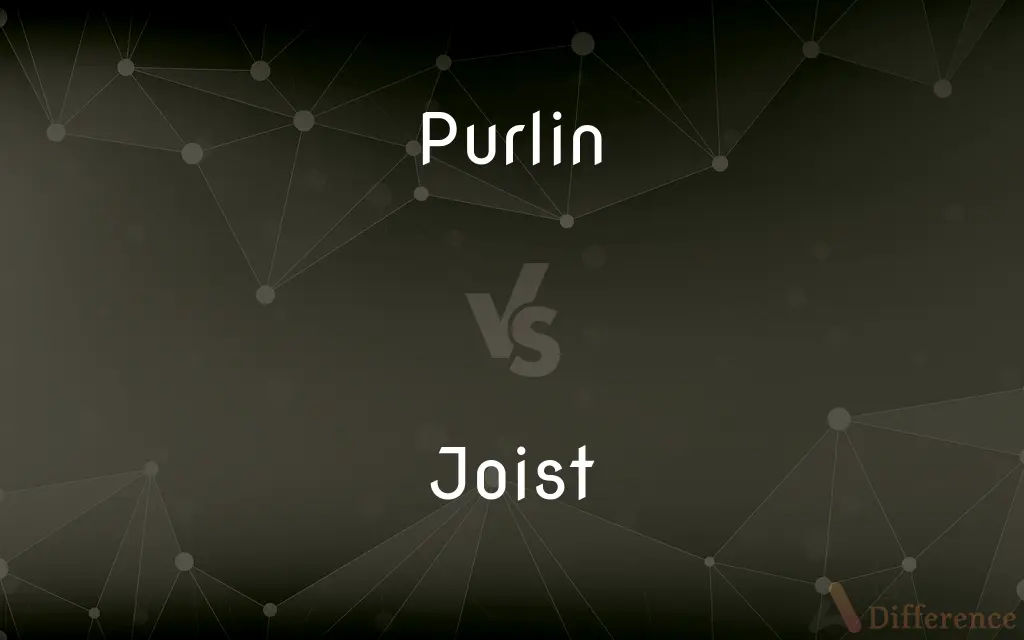Purlin vs. Joist — What's the Difference?
By Maham Liaqat & Urooj Arif — Updated on March 22, 2024
A purlin supports roof panels, running parallel to the building ridge, offers structural support to the roof deck, while a joist supports floors or ceilings, running perpendicular to the primary direction of framing, distributing load to structural walls.

Difference Between Purlin and Joist
Table of Contents
ADVERTISEMENT
Key Differences
Purlins are horizontal beams laid across trusses to support the roof deck, cladding, or sheeting, playing a key role in roof structures by distributing loads to the primary building frame. They are essential in reducing the span of rafters by providing additional support points, which allows for the use of fewer materials and can contribute to cost efficiency in construction. On the other hand, joists are crucial components of floor and ceiling frameworks, providing the backbone on which floorboards, plasterboard, or other surface materials are laid. They function by spanning between walls or beams, distributing the weight of people, furniture, and other contents evenly across the structure.
Purlins are often made from wood, steel, or aluminum, depending on the architectural requirements and the type of roof. Joists are typically made of wood in residential construction but can also be made from steel, especially in commercial or industrial buildings, where longer spans or heavier loads are expected.
The orientation of purlins and joists relative to the primary structure is a significant difference. Purlins usually run parallel to the ridge line of a roof, helping to tie the roof structure together, while joists run perpendicular to the primary direction of framing, helping to tie the structural walls together and support the floors or ceilings.
Another distinction is in their applications and implications for design. Purlins allow for larger roof spans without requiring closely spaced rafters, which can lead to more open attic spaces or higher ceilings. Joists, when properly sized and spaced, enable the construction of sturdy floors and ceilings that can support significant loads without excessive deflection, contributing to the overall comfort and safety of a building.
Despite their different applications, both purlins and joists are fundamental in shaping the structural integrity of buildings, influencing both the design and functionality of roofs, floors, and ceilings.
ADVERTISEMENT
Comparison Chart
Function
Supports roof panels and cladding.
Supports floors and ceilings.
Orientation
Runs parallel to the building ridge.
Runs perpendicular to the main direction of framing.
Material
Wood, steel, aluminum.
Wood, steel.
Load
Distributes roof loads to the primary frame.
Distributes floor or ceiling loads to structural walls.
Design Impact
Allows for larger spans in roof construction.
Enables sturdy floors and ceilings with minimal deflection.
Compare with Definitions
Purlin
Can be used in various types of roof structures, including traditional and modern designs.
The use of wooden purlins added a rustic charm to the renovated barn's roof.
Joist
A horizontal structure supporting a floor or ceiling.
The floor joists were carefully inspected for signs of wear or damage during the renovation.
Purlin
Often installed parallel to the ridge line of the roof.
The purlins were positioned parallel to the ridge, providing additional support for the roofing material.
Joist
Typically made from wood in residential buildings, but steel is common in commercial construction.
Steel joists were used in the office building to accommodate the open floor plan.
Purlin
Varies in material based on architectural needs and the type of construction.
Aluminum purlins were chosen for their lightweight and durability in the coastal climate.
Joist
Runs perpendicular to the primary framing direction, distributing weight evenly.
The joists ran perpendicular to the main beams, evenly supporting the floor above.
Purlin
Reduces the span of rafters and trusses, enabling wider roof spans.
By using purlins, they reduced the number of rafters needed, saving on construction costs.
Joist
Essential for creating safe, level, and sturdy surfaces in buildings.
Properly spaced joists ensured that the hardwood flooring was both beautiful and secure.
Purlin
A horizontal beam supporting the roof of a building.
The architect specified steel purlins to support the wide-span metal roof.
Joist
Integral to the stability and strength of floors and ceilings.
Additional joists were added to support the heavy marble tiles in the foyer.
Purlin
A purlin (or historically purline, purloyne, purling, perling) is a longitudinal, horizontal, structural member in a roof. In traditional timber framing there are three basic types of purlin: purlin plate, principal purlin, and common purlin.
Joist
A joist is a horizontal structural member used in framing to span an open space, often between beams that subsequently transfer loads to vertical members. When incorporated into a floor framing system, joists serve to provide stiffness to the subfloor sheathing, allowing it to function as a horizontal diaphragm.
Purlin
One of several horizontal timbers supporting the rafters of a roof.
Joist
Any of the wood, steel, or concrete beams set parallel from wall to wall or across or abutting girders to support a floor or ceiling.
Purlin
A longitudinal structural member bridging two or more rafters of a roof.
Joist
To construct with joists.
Purlin
In root construction, a horizontal member supported on the principals and supporting the common rafters.
Joist
A piece of timber or steel laid horizontally, or nearly so, to which the planks of the floor, or the laths or furring strips of a ceiling, are nailed.
Joist
(transitive) To fit or furnish with joists.
Joist
To fit or furnish with joists.
Joist
Beam used to support floors or roofs
Common Curiosities
What is a purlin in construction?
A purlin is a horizontal beam that supports the roof of a building, helping to distribute the load to the primary frame.
How do joists work?
Joists work by spanning between walls or beams to support floors and ceilings, evenly distributing the load across the structure.
What materials are used for joists and purlins?
Joists and purlins can be made from wood, steel, or aluminum, with the choice depending on the specific requirements of the construction.
How do the orientations of purlins and joists differ?
Purlins run parallel to the ridge line of a roof, while joists run perpendicular to the main direction of framing in floors and ceilings.
Why are purlins important in roof construction?
Purlins are important because they allow for larger spans between rafters, reducing material costs and enabling more flexible roof designs.
How does the spacing of joists affect a floor's performance?
Proper spacing is crucial for minimizing deflection and ensuring the floor is stable and strong enough to support expected loads without excessive bending.
Can purlins be used for floors?
Purlins are specifically designed for roof support and are not typically used for floors, which are supported by joists.
What role do joists play in a building's structure?
Joists provide the foundational support for floors and ceilings, ensuring the structure can support the weight of people, furniture, and other contents safely.
What are some design considerations when choosing between purlins and joists?
Design considerations include the type of support needed (roof vs. floor/ceiling), span length, load requirements, material preferences, and architectural aesthetics.
Can the material of purlins and joists affect a building's design?
Yes, the choice of material can significantly impact the design, with steel allowing for longer spans and wood offering a traditional aesthetic.
Share Your Discovery

Previous Comparison
Reflectance vs. Albedo
Next Comparison
Dissension vs. DissentAuthor Spotlight
Written by
Maham LiaqatCo-written by
Urooj ArifUrooj is a skilled content writer at Ask Difference, known for her exceptional ability to simplify complex topics into engaging and informative content. With a passion for research and a flair for clear, concise writing, she consistently delivers articles that resonate with our diverse audience.














































